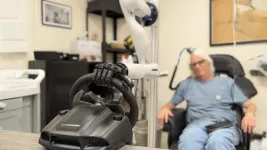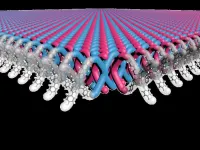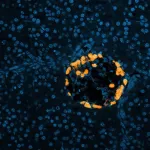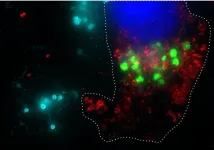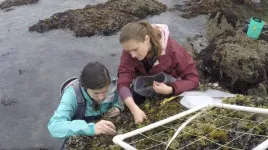(Press-News.org) You can probably complete an amazing number of tasks with your hands without looking at them. But if you put on gloves that muffle your sense of touch, many of those simple tasks become frustrating. Take away proprioception — your ability to sense your body’s relative position and movement — and you might even end up breaking an object or injuring yourself.
“Most people don’t realize how often they rely on touch instead of vision — typing, walking, picking up a flimsy cup of water,” said Charles Greenspon, PhD, a neuroscientist at the University of Chicago. “If you can’t feel, you have to constantly watch your hand while doing anything, and you still risk spilling, crushing or dropping objects.”
Greenspon and his research collaborators recently published papers in Nature Biomedical Engineering and Science documenting major progress on a technology designed to address precisely this problem: direct, carefully timed electrical stimulation of the brain that can recreate tactile feedback to give nuanced “feeling” to prosthetic hands.
The science of restoring sensation
These new studies build on years of collaboration among scientists and engineers at UChicago, the University of Pittsburgh, Northwestern University, Case Western Reserve University and Blackrock Neurotech. Together they are designing, building, implementing and refining brain-computer interfaces (BCIs) and robotic prosthetic arms aimed at restoring both motor control and sensation in people who have lost significant limb function.
On the UChicago side, the research was led by neuroscientist Sliman Bensmaia, PhD, until his unexpected passing in 2023.
The researchers’ approach to prosthetic sensation involves placing tiny electrode arrays in the parts of the brain responsible for moving and feeling the hand. On one side, a participant can move a robotic arm by simply thinking about movement, and on the other side, sensors on that robotic limb can trigger pulses of electrical activity called intracortical microstimulation (ICMS) in the part of the brain dedicated to touch.
For about a decade, Greenspon explained, this stimulation of the touch center could only provide a simple sense of contact in different places on the hand.
“We could evoke the feeling that you were touching something, but it was mostly just an on/off signal, and often it was pretty weak and difficult to tell where on the hand contact occurred,” he said.
The newly published results mark important milestones in moving past these limitations.
Advancing understanding of artificial touch
In the first study, published in Nature Biomedical Engineering, Greenspon and his colleagues focused on ensuring that electrically evoked touch sensations are stable, accurately localized and strong enough to be useful for everyday tasks.
By delivering short pulses to individual electrodes in participants’ touch centers and having them report where and how strongly they felt each sensation, the researchers created detailed “maps” of brain areas that corresponded to specific parts of the hand. The testing revealed that when two closely spaced electrodes are stimulated together, participants feel a stronger, clearer touch, which can improve their ability to locate and gauge pressure on the correct part of the hand.
The researchers also conducted exhaustive tests to confirm that the same electrode consistently creates a sensation corresponding to a specific location.
“If I stimulate an electrode on day one and a participant feels it on their thumb, we can test that same electrode on day 100, day 1,000, even many years later, and they still feel it in roughly the same spot,” said Greenspon, who was the lead author on this paper.
From a practical standpoint, any clinical device would need to be stable enough for a patient to rely on it in everyday life. An electrode that continually shifts its “touch location” or produces inconsistent sensations would be frustrating and require frequent recalibration. By contrast, the long-term consistency this study revealed could allow prosthetic users to develop confidence in their motor control and sense of touch, much as they would in their natural limbs.
Adding feelings of movement and shapes
The complementary Science paper went a step further to make artificial touch even more immersive and intuitive. The project was led by first author Giacomo Valle, PhD, a former postdoctoral fellow at UChicago who is now continuing his bionics research at Chalmers University of Technology in Sweden.
“Two electrodes next to each other in the brain don’t create sensations that ‘tile’ the hand in neat little patches with one-to-one correspondence; instead, the sensory locations overlap,” explained Greenspon, who shared senior authorship of this paper with Bensmaia.
The researchers decided to test whether they could use this overlapping nature to create sensations that could let users feel the boundaries of an object or the motion of something sliding along their skin. After identifying pairs or clusters of electrodes whose “touch zones” overlapped, the scientists activated them in carefully orchestrated patterns to generate sensations that progressed across the sensory map.
Participants described feeling a gentle gliding touch passing smoothly over their fingers, despite the stimulus being delivered in small, discrete steps. The scientists attribute this result to the brain’s remarkable ability to stitch together sensory inputs and interpret them as coherent, moving experiences by “filling in” gaps in perception.
The approach of sequentially activating electrodes also significantly improved participants’ ability to distinguish complex tactile shapes and respond to changes in the objects they touched. They could sometimes identify letters of the alphabet electrically “traced” on their fingertips, and they could use a bionic arm to steady a steering wheel when it began to slip through the hand.
These advancements help move bionic feedback closer to the precise, complex, adaptive abilities of natural touch, paving the way for prosthetics that enable confident handling of everyday objects and responses to shifting stimuli.
The future of neuroprosthetics
The researchers hope that as electrode designs and surgical methods continue to improve, the coverage across the hand will become even finer, enabling more lifelike feedback.
“We hope to integrate the results of these two studies into our robotics systems, where we have already shown that even simple stimulation strategies can improve people’s abilities to control robotic arms with their brains,” said co-author Robert Gaunt, PhD, associate professor of physical medicine and rehabilitation and lead of the stimulation work at the University of Pittsburgh.
Greenspon emphasized that the motivation behind this work is to enhance independence and quality of life for people living with limb loss or paralysis.
“We all care about the people in our lives who get injured and lose the use of a limb — this research is for them,” he said. “This is how we restore touch to people. It’s the forefront of restorative neurotechnology, and we’re working to expand the approach to other regions of the brain.”
The approach also holds promise for people with other types of sensory loss. In fact, the group has also collaborated with surgeons and obstetricians at UChicago on the Bionic Breast Project, which aims to produce an implantable device that can restore the sense of touch after mastectomy.
Although many challenges remain, these latest studies offer evidence that the path to restoring touch is becoming clearer. With each new set of findings, researchers come closer to a future in which a prosthetic body part is not just a functional tool, but a way to experience the world.
“Evoking stable and precise tactile sensations via multi-electrode intracortical microstimulation of the somatosensory cortex” was published in Nature Biomedical Engineering in December 2024. Authors include Charles M. Greenspon, Giacomo Valle, Natalya D. Shelchkova, Thierri Callier, Ev I. Berger-Wolf, Elizaveta V. Okorokova, Efe Dogruoz, Anton R. Sobinov, Patrick M. Jordan, Emily E. Fitzgerald, Dillan Prasad, Ashley Van Driesche, Qinpu He, David Satzer, Peter C. Warnke, John E. Downey, Nicholas G. Hatsopoulos and Sliman J. Bensmaia from the University of Chicago; Taylor G. Hobbs, Ceci Verbaarschot, Jeffrey M. Weiss, Fang Liu, Jorge Gonzalez-Martinez, Michael L. Boninger, Jennifer L. Collinger and Robert A. Gaunt from the University of Pittsburgh; Brianna C. Hutchison, Robert F. Kirsch, Jonathan P. Miller, Abidemi B. Ajiboye, Emily L. Graczyk, from Case Western Reserve University; Lee E. Miller from Northwestern University; and Ray C. Lee from Schwab Rehabilitation Hospital.
“Tactile edges and motion via patterned microstimulation of the human somatosensory cortex” was published in Science in January 2025. Authors include Giacomo Valle, now at Chalmers University in Sweden; Ali H. Alamri, John E. Downey, Patrick M. Jordan, Anton R. Sobinov, Linnea J. Endsley, Dillan Prasad, Peter C. Warnke, Nicholas G. Hatsopoulos, Charles M. Greenspon and Sliman J. Bensmaia from the University of Chicago; Robin Lienkämper, Michael L. Boninger, Jennifer L. Collinger and Robert A. Gaunt from the University of Pittsburgh; and Lee E. Miller from Northwestern University.
END
Fine-tuned brain-computer interface makes prosthetic limbs feel more real
Two new papers document progress in neuroprosthetic technology that lets people feel the shape and movement of objects moving over the "skin" of a bionic hand
2025-01-16
ELSE PRESS RELEASES FROM THIS DATE:
New chainmail-like material could be the future of armor
2025-01-16
EVANSTON, Il. --- In a remarkable feat of chemistry, a Northwestern University-led research team has developed the first two-dimensional (2D) mechanically interlocked material.
Resembling the interlocking links in chainmail, the nanoscale material exhibits exceptional flexibility and strength. With further work, it holds promise for use in high-performance, light-weight body armor and other uses that demand lightweight, flexible and tough materials.
Publishing on Friday (Jan. 17) in the journal ...
The megadroughts are upon us
2025-01-16
Increasingly common since 1980, persistent multi-year droughts will continue to advance with the warming climate, warns a study from the Swiss Federal Institute for Forest, Snow, and Landscape Research (WSL), with Professor Francesca Pellicciotti from the Institute of Science and Technology Austria (ISTA) participating. This publicly available forty-year global quantitative inventory, now published in Science, seeks to inform policy regarding the environmental impact of human-induced climate change. It also detected previously ‘overlooked’ events.
Fifteen years of a persistent, devastating megadrought—the longest lasting in a thousand years—have nearly dried out ...
Eavesdropping on organs: Immune system controls blood sugar levels
2025-01-16
When we think about the immune system, we usually associate it with fighting infections. However, a study published in Science by the Champalimaud Foundation reveals a surprising new role. During periods of low energy—such as intermittent fasting or exercise—immune cells step in to regulate blood sugar levels, acting as the “postman” in a previously unknown three-way conversation between the nervous, immune and hormonal systems. These findings open up new approaches for managing conditions like diabetes, obesity, and cancer.
Rethinking the Immune ...
Quantum engineers ‘squeeze’ laser frequency combs to make more sensitive gas sensors
2025-01-16
The trick to creating a better quantum sensor? Just give it a little squeeze.
For the first time ever, scientists have used a technique called “quantum squeezing” to improve the gas sensing performance of devices known as optical frequency comb lasers. These ultra-precise sensors are like fingerprint scanners for molecules of gas. Scientists have used them to spot methane leaks in the air above oil and gas operations and signs of COVID-19 infections in breath samples from humans.
Now, in a series of lab experiments, researchers have laid out a path for making those kinds of measurements even more sensitive and faster—doubling the speed of ...
New study reveals how climate change may alter hydrology of grassland ecosystems
2025-01-16
New research co-led by the University of Maryland reveals that drought and increased temperatures in a CO2-rich climate can dramatically alter how grasslands use and move water. The study provides the first experimental demonstration of the potential impacts of climate change on water movement through grassland ecosystems, which make up nearly 40% of Earth’s land area and play a critical role in Earth’s water cycle. The study appears in the January 17, 2025, issue of the journal Science.
“If we want to predict the effects of climate change ...
Polymer research shows potential replacement for common superglues with a reusable and biodegradable alternative
2025-01-16
EMBARGO: THIST CONTENT IS UNDER EMBARGO UNTIL 2 PM U.S. EASTERN STANDARD TIME ON JANUARY 16, 2025. INTERESTED MEDIA MAY RECIVE A PREVIEW COPY OF THE JOURNAL ARTICLE IN ADVANCE OF THAT DATE OR CONDUCT INTERVIEWS, BUT THE INFORMATION MAY NOT BE PUBLISHED, BROADCAST, OR POSTED ONLINE UNTIL AFTER THE RELEASE WINDOW.
Researchers at Colorado State University and their partners have developed an adhesive polymer that is stronger than current commercially available options while also being biodegradable ...
Research team receives $1.5 million to study neurological disorders linked to long COVID
2025-01-16
The National Institute of Mental Health has awarded a significant grant of $1.5 million to Jianyang Du, PhD, of the University of Tennessee Health Science Center, for a research study aimed at uncovering the cellular and molecular mechanisms that lead to neurological disorders caused by long COVID-19.
Dr. Du is an associate professor at the College of Medicine in the Department of Anatomy and Neurobiology. Colleen Jonsson, PhD, director of the UT Health Science Center Regional Biocontainment Laboratory and professor in the Department of Microbiology, is co-investigator on the grant, and Kun Li, PhD, assistant ...
Research using non-toxic bacteria to fight high-mortality cancers prepares for clinical trials
2025-01-16
A University of Massachusetts Amherst-Ernest Pharmaceuticals team of scientists has made “exciting,” patient-friendly advances in developing a non-toxic bacterial therapy, BacID, to deliver cancer-fighting drugs directly into tumors. This emerging technology holds promise for very safe and more effective treatment of cancers with high mortality rates, including liver, ovarian and metastatic breast cancer.
Clinical trials with participating cancer patients are estimated to begin in 2027. “This is exciting because we now have all the critical pieces for getting an effective bacterial ...
Do parents really have a favorite child? Here’s what new research says
2025-01-16
Siblings share a unique bond built from shared memories, family rituals and the occasional argument. But ask almost anyone with a brother or sister and you’ll likely find a longstanding debate: who’s the favorite? New research from BYU sheds some light on that playful rivalry, revealing how parents might subtly show favoritism based on birth order, personality and gender.
The study, conducted by BYU School of Family Life professor Alex Jensen, found that younger siblings generally receive more favorable ...
Mussel bed surveyed before World War II still thriving
2025-01-16
A mussel bed along Northern California’s Dillon Beach is as healthy and biodiverse as it was about 80 years ago, when two young students surveyed it shortly before Pearl Harbor was attacked and one was sent to fight in World War II.
Their unpublished, typewritten manuscript sat in the UC Davis Bodega Marine Laboratory’s library for years until UC Davis scientists found it and decided to resurvey the exact same mussel bed with the old paper’s meticulous photos and maps directing their way.
The new findings, published in the journal Scientific Reports, document ...
LAST 30 PRESS RELEASES:
Tracing the quick synthesis of an industrially important catalyst
New software sheds light on cancer’s hidden genetic networks
UT Health San Antonio awarded $3 million in CPRIT grants to bolster cancer research and prevention efforts in South Texas
Third symposium spotlights global challenge of new contaminants in China’s fight against pollution
From straw to soil harmony: International team reveals how biochar supercharges carbon-smart farming
Myeloma: How AI is redrawing the map of cancer care
Manhattan E. Charurat, Ph.D., MHS invested as the Homer and Martha Gudelsky Distinguished Professor in Medicine at the University of Maryland School of Medicine
Insilico Medicine’s Pharma.AI Q4 Winter Launch Recap: Revolutionizing drug discovery with cutting-edge AI innovations, accelerating the path to pharmaceutical superintelligence
Nanoplastics have diet-dependent impacts on digestive system health
Brain neuron death occurs throughout life and increases with age, a natural human protein drug may halt neuron death in Alzheimer’s disease
SPIE and CLP announce the recipients of the 2025 Advanced Photonics Young Innovator Award
Lessons from the Caldor Fire’s Christmas Valley ‘Miracle’
Ant societies rose by trading individual protection for collective power
Research reveals how ancient viral DNA shapes early embryonic development
A molecular gatekeeper that controls protein synthesis
New ‘cloaking device’ concept to shield sensitive tech from magnetic fields
Researchers show impact of mountain building and climate change on alpine biodiversity
Study models the transition from Neanderthals to modern humans in Europe
University of Phoenix College of Doctoral Studies releases white paper on AI-driven skilling to reduce burnout and restore worker autonomy
AIs fail at the game of visual “telephone”
The levers for a sustainable food system
Potential changes in US homelessness by ending federal support for housing first programs
Vulnerability of large language models to prompt injection when providing medical advice
Researchers develop new system for high-energy-density, long-life, multi-electron transfer bromine-based flow batteries
Ending federal support for housing first programs could increase U.S. homelessness by 5% in one year, new JAMA study finds
New research uncovers molecular ‘safety switch’ shielding cancers from immune attack
Bacteria resisting viral infection can still sink carbon to ocean floor
Younger biological age may increase depression risk in older women during COVID-19
Bharat Innovates 2026 National Basecamp Showcases India’s Most Promising Deep-Tech Ventures
Here’s what determines whether your income level rises or falls
[Press-News.org] Fine-tuned brain-computer interface makes prosthetic limbs feel more realTwo new papers document progress in neuroprosthetic technology that lets people feel the shape and movement of objects moving over the "skin" of a bionic hand
